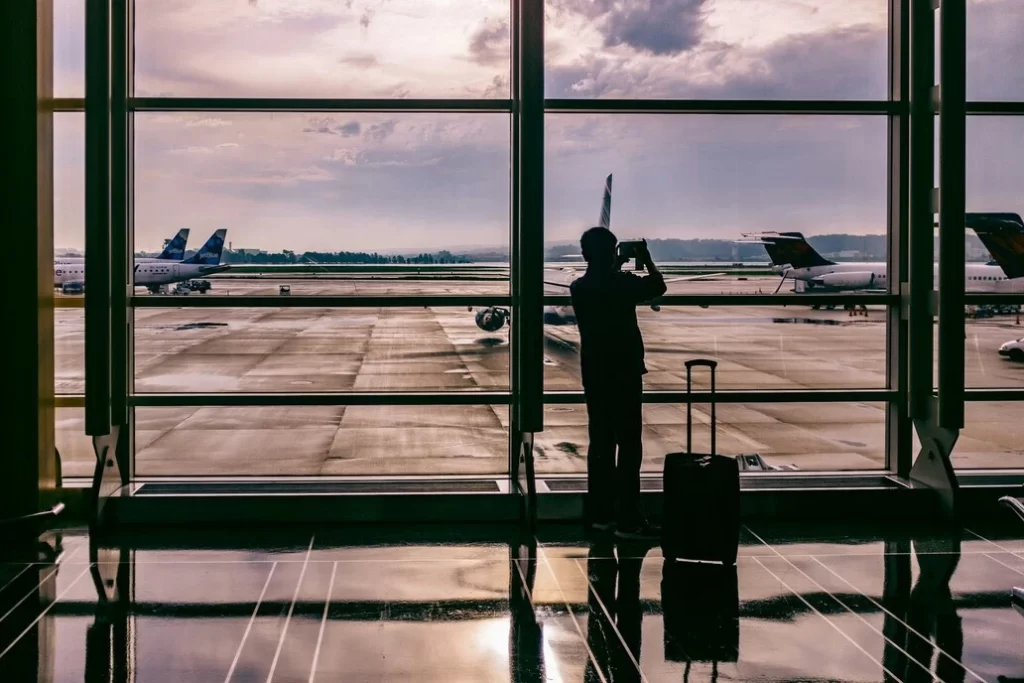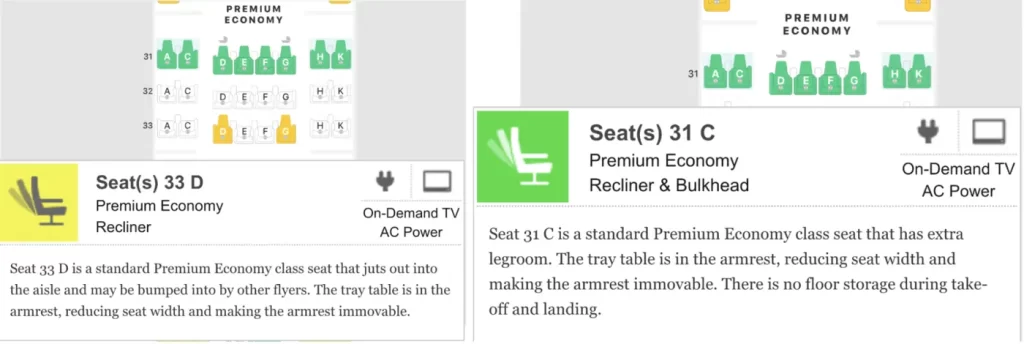
Flying can be an exhilarating experience, but it can also be associated with stress and discomfort. The reality is that for many travelers, navigating crowded airports or enduring long flights can evoke feelings of stress and discomfort. Fortunately, the right tools and tips can create more comfortable and tranquil flying experience.
Before a flight, calming your nerves involves a myriad of strategies, from seat selection and smart packing to tackling flight-induced problems like ear pain and potential dehydration. For a smooth experience, most of these preparations should be done before flying, and some well before arriving at the airport.
Without further ado, let’s dive into 10 of these strategies.
1. Select your seat in a timely and resourceful way
The process of flying comfortably begins as early as selecting your flight logistics.
Even if you cannot afford to fly in a premium class, seat selection is an option that can significantly impact your comfort during a flight. It is typically available for free during online check-in, which is typically open 24-48 hours before a flight.
How do you go about selecting seats? You may not know this, but you can be resourceful in finding comfortable seats via a free application like SeatGuru:
- Visit the SeatGuru website before your flight. Enter information about your flight, such as your airline, flight number, and travel date.
- This enables you to find your flight.
- Thereafter, review the seating map of the aircraft, which indicates the layout of seats, the amenities available at different seats, and the drawbacks or advantages of various seats.
Seat Guru color codes various seats in green, yellow, or red. While red seats are considered poor choices, yellow seats typically have certain drawbacks but may be fine, while green seats have advantages.

Take note of seat features such as legroom, seat width, proximity to restrooms, and in-flight entertainment options.
Using the info you gathered, identify the seat(s) you want by noting the seat number(s) for reference during online check-in.
If you wish to skip viewing online seat maps, you can instead make quick and logical decisions. You may prefer a window seat offering a view and a spot to rest your head. On the other hand, aisle seats provide easier access to the restroom but suffer more disturbances from other travelers entering and exiting. If you’re taller, exit-row seats offer more legroom and may be better for you.
2. Prepare ergonomic tools based on your seat and flight itinerary
Fundamentally, airplanes are not designed with ergonomics in mind but to cramp as many passengers as safely as possible. Unless you are traveling in business class with ergonomics well taken care of, you will typically experience muscle strain and pain in your shoulders, back, and legs during and after your flight.
This begs the question of whether you should prioritize ergonomics and to what extent.
Arguably, ergonomics should be prioritized for these types of flights: Longer flights and overnight flights when you are supposed to be sleeping. While you might be able to endure a short 1-3 hour flight in an uncomfortable position, you probably shouldn’t for a longer flight exceeding 3 hours. During rest, you want to create a sleeping environment that is as optimal as you can get.
How do you improve your ergonomics on a plane?
Besides upgrading your flight class and seat selections, you may opt to bring certain tools such as neck pillows, lumbar cushions, or footrests to enhance your comfort.
- For instance, a lumbar support pillow or cushion can promote better curvature of your back, supporting the natural curve of the lumbar spine. However, if you do not wish to carry such an extra item or weight onboard a plane, simply use an existing tool you already have — place a rolled-up towel, T-shirt, or jacket behind your back.
- Neck pillows are designed to support the neck and head, which can help prevent stiffness and discomfort during long periods of sitting such as during a flight.
- Footrests elevate the feet, promoting better circulation and relieving numbness to a certain extent.
This article was originally published on unboundist.com. If it is now published on any other site, it was done without permission from the copyright owner.
3. Be prepared logistically, mentally, and emotionally
To fly comfortably, you want to be fully prepared. Full preparation extends beyond flight logistics – it includes your mental and emotional state. It also involves some preparations before a flight that someone who isn’t quite travel-savvy and experienced might miss.
Here are some examples of doing the right things before boarding a plane:
- Managing hunger before a flight: If you neglect to eat well before a flight, you might end up dealing with hunger and purchasing expensive food at the airport or onboard the plane.
- Avoiding foods that make you feel gassy (like fried foods and beans) or dehydrated (like coffee and alcohol): You want to avoid bloatedness and gut problems that make you fart more. You want to avoid dehydration which is a health risk and hinders sleep.
- Packing well for airport navigation and security screening: You do not want to bring prohibited items that will be confiscated by airport security staff and experience delays in boarding your flight, which can also inconvenience other passengers
- Peeing
- Being at the boarding gate on time: Boarding gates often open and close earlier than your scheduled departure time — be aware of this.
- Tracking your flight to be aware of itinerary changes
For relaxation, techniques such as deep breathing or meditation can help.
If you are an inexperienced flier, it’ll benefit you to learn what goes on during a flight, such as turbulence, and how to navigate the airport smoothly to avoid hiccups. Thus, we put together the best tips in a guide for inexperienced or first-time flyers, covering the entire preparation process from start to end — it can be replicated no matter where you are traveling.
4. Pack items strategically for in-flight access
Many inexperienced flyers may neglect packing well for in-flight comfort. Organizing your bag strategically to ensure easy access to personal items can make a world of difference during the flight.
First, you should keep the items you need on the plane in your personal item bag, rather than your carry-on bag which will be stowed in the overhead bins. Your personal item bag will be placed under the seat in front of you and easily accessible.
Second, you want to keep things organized and within reach in your bag. That means organizing your travel documents, snacks, entertainment devices, medication, and whatever else you need in easily reachable pockets or sections of your bag — to avoid rummaging through your bag mid-flight.
Third, consider other factors beyond in-flight convenience. Organize your entire backpack strategically to streamline security screening, safeguard against potential damage during your trip, and prevent overpacking.
Consider all aspects of packing to avoid all problems at the airport and onboard the plane. It will boost your overall travel experience.
5. Manage ear pain during takeoff and landing
Ear pain is something to manage during takeoff and landing. Some of you may have this problem, but some travelers won’t.
During takeoff and landing, cabin pressure changes occur, affecting the gases in our bodies. As air pressure changes when the aircraft ascends or descends, it creates a disparity on either side of the eardrums, resulting in discomfort or pressure. This can lead to headaches, particularly if air becomes trapped in the sinuses.
To alleviate ear discomfort during takeoff and landing, try swallowing. Chewing gum, sucking on mints, or sipping water during takeoff and landing are things that encourage swallowing, and have anecdotally helped many travelers who experience ear pain. Yawning also helps.
However, these methods may not work for everyone. Thus, you may want to invest in a pair of specialized earplugs to bring pressure relief. For instance, the Earplanes or Alpine Flyfit earplugs have anecdotally helped many travelers. Some travelers swear by these tools. Ultimately, you should find a solution that works best for you.
6. Bring medication
Medication is one of the last items you want to neglect for a flight. They are crucial.
If you’re prone to motion sickness or anxiety, consider bringing medication prescribed by your doctor. You may also want to bring remedies for nausea or sleep aids. Some pain relief medications like paracetamol are also useful in bringing calm if you feel unwell.
7. Refill your empty water bottle before boarding
Dehydration can happen, especially on long-haul flights. This risk increases with the duration of your flight, and there is science behind this. Low humidity is a factor – airplane cabins have lower humidity levels than the average indoor humidity levels. As a result, the dry air in the airplane cabin can cause increased evaporation of moisture from one’s skin, contributing to dehydration
Dehydration causes your skin to feel dry on an airplane. A moisturizing stick can help, but drinking lots of water is a clear and direct solution to the problem.
Before you board the plane, refill your water bottle, and avoid coffee and alcohol, especially for long-haul flights.
8. Bring noise-cancelling headphones or earplugs
Noise-cancelling headphones or earplugs are highly suggested items by travelers to bring onboard a flight. Flying may already be an anxiety-inducing experience for some, but what could make it worse are crying babies and loud engine noises.
You can reduce or eliminate the experience of hearing unwanted noises with a good pair of earplugs or noise-cancelling headphones.
9. Dress in layers of comfortable clothing
Dressing in layers allows you to easily adjust to changing temperatures in the cabin. You can stay comfortable. When it’s colder on the plane, simply put on outer layers like your jacket. When temperatures are warmer, you can be dressed in a tank top or T-shirt if you like.
In addition, all the layers of your clothing should be comfortable. Avoid wearing tight pieces of clothing that restrict movement or circulation. Bear in mind that space and movement are limited on the plane and in your seat, so you certainly would not want your clothing to heighten discomfort even more.
10. Consume content on your smartphone hands-free
Last but not least, consume entertainment in a way that isn’t tedious or straining.
If you have videos downloaded on your smartphone, watch them comfortably without having to hold your device for extended periods.
If you do not have a smartphone holder which can be too bulky for travel, adopt creative solutions to prop up your device. Here are two examples:
- Use a pop socket: You can use a pop socket, a small, collapsible accessory that attaches to the back of your smartphone. Position it on the back of your phone, and lock it into place to form a stable base for your phone. Then place your phone horizontally on the tray table of the airplane seat in front of you.
- Suspend your phone by hanging it in a clear bag: At your seat, locate the hook or latch on the underside of the tray table in front of you. Storing your phone in a clear plastic or resealable bag, hang the bag from the tray table hook. To suspend the bag securely in place, keep the tray table closed. You can now watch a movie hands-free.
Pick and implement a few tools and tips mentioned in this article, and make your next journey a calm and comfortable experience from takeoff to landing. Bon voyage!